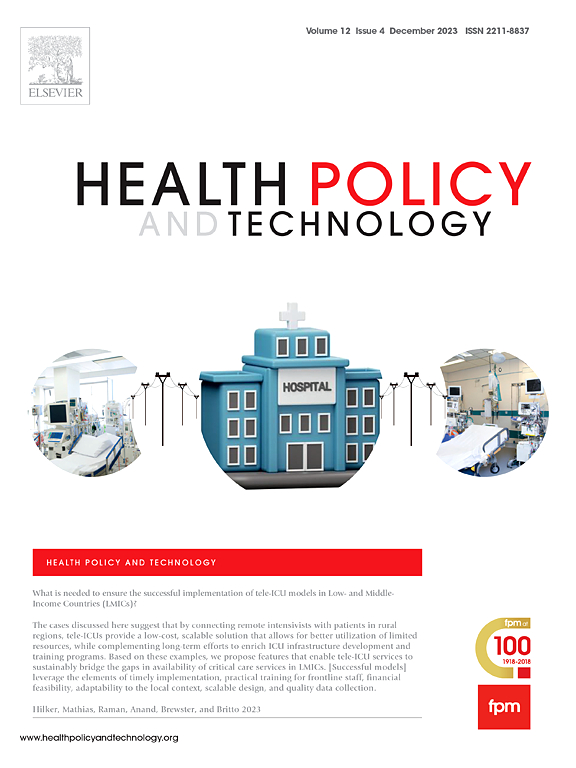Global ChatGPT interest across healthcare and education access
IF 3.7
3区 医学
Q1 HEALTH POLICY & SERVICES
引用次数: 0
Abstract
Objectives
The rapid adoption of AI tools like ChatGPT has transformed information access, particularly in healthcare. However, engagement with AI may be influenced by factors such as healthcare accessibility and educational resources, with potential implications for misinformation in low-resource settings. This study investigates the relationship between physician density, tertiary education enrollment, and national interest in ChatGPT.
Methods
A cross-sectional analysis was conducted using global datasets. Physician density, tertiary education enrollment, GDP, and internet penetration were sourced from WHO, UNESCO, and the World Bank, respectively. The primary outcome, ChatGPT interest scores, was derived from Google Trends. Pearson correlation and multiple linear regression analyses were used to explore associations, controlling for GDP and internet penetration. Logistic regression was employed as a sensitivity analysis, categorizing variables into high and low groups.
Results
Data from 100 countries were analyzed. A significant negative correlation was observed between physician density and ChatGPT interest (r = -0.32, p = 0.012). Multiple linear regression confirmed that lower physician density was significantly associated with higher ChatGPT interest (β = -0.2857, p = 0.045). Tertiary education enrollment showed no significant association with ChatGPT interest. Logistic regression supported these findings, with higher physician density significantly reducing the likelihood of high ChatGPT interest (OR = 0.214, p = 0.001).
Conclusion
Our study suggests that regions with fewer healthcare professionals may engage more with AI tools like ChatGPT, highlighting the need for careful integration of AI into healthcare systems to prevent misinformation and support equitable access to reliable health information.
Public Interest Summary
It is well known that people who have difficulty in accessing healthcare may turn to the internet for medical advice, but it is not yet known if artificial intelligence, like ChatGPT, is being adopted by users for this same purpose. Given the widespread use of ChatGPT, this study explored whether ChatGPT interest in different countries was related to the number of physicians in those countries. We found that in countries with fewer doctors per capita, public interest in ChatGPT tends to be higher. While this does not confirm that people are using ChatGPT specifically for medical advice, it raises important questions about how AI may be filling gaps in access to healthcare. Given the potential for AI to spread inaccurate information, these findings highlight the need for careful regulation to ensure AI tools are used responsibly and do not contribute to misinformation in healthcare.
全球ChatGPT对医疗保健和教育访问的兴趣
ChatGPT等人工智能工具的迅速采用改变了信息访问方式,特别是在医疗保健领域。然而,与人工智能的接触可能会受到医疗保健可及性和教育资源等因素的影响,在资源匮乏的环境中可能会产生错误信息。本研究调查了医师密度、高等教育入学率和国家对ChatGPT的兴趣之间的关系。方法采用全球数据集进行横断面分析。医生密度、高等教育入学率、GDP和互联网普及率分别来自世卫组织、联合国教科文组织和世界银行。主要结果ChatGPT兴趣评分来源于谷歌Trends。使用Pearson相关和多元线性回归分析来探索关联,控制GDP和互联网普及率。采用Logistic回归作为敏感性分析,将变量分为高组和低组。结果分析了来自100个国家的数据。医师密度与ChatGPT兴趣呈显著负相关(r = -0.32, p = 0.012)。多元线性回归证实,较低的医师密度与较高的ChatGPT兴趣显著相关(β = -0.2857, p = 0.045)。高等教育入学率与ChatGPT兴趣无显著关联。Logistic回归支持这些发现,较高的医生密度显著降低了ChatGPT高兴趣的可能性(OR = 0.214, p = 0.001)。我们的研究表明,医疗保健专业人员较少的地区可能会更多地使用ChatGPT等人工智能工具,这突出了将人工智能仔细整合到医疗保健系统中以防止错误信息并支持公平获取可靠卫生信息的必要性。公共利益摘要众所周知,难以获得医疗服务的人可能会转向互联网寻求医疗建议,但目前尚不清楚用户是否正在采用人工智能(如ChatGPT)来实现同样的目的。鉴于ChatGPT的广泛使用,本研究探讨了不同国家对ChatGPT的兴趣是否与这些国家的医生数量有关。我们发现,在人均医生人数较少的国家,公众对ChatGPT的兴趣往往更高。虽然这并不能证实人们使用ChatGPT是专门为了获得医疗建议,但它提出了一个重要的问题,即人工智能将如何填补获得医疗保健的空白。鉴于人工智能有可能传播不准确的信息,这些发现强调了谨慎监管的必要性,以确保人工智能工具得到负责任的使用,不会导致医疗保健领域的错误信息。
本文章由计算机程序翻译,如有差异,请以英文原文为准。
求助全文
约1分钟内获得全文
求助全文
来源期刊

Health Policy and Technology
Medicine-Health Policy
CiteScore
9.20
自引率
3.30%
发文量
78
审稿时长
88 days
期刊介绍:
Health Policy and Technology (HPT), is the official journal of the Fellowship of Postgraduate Medicine (FPM), a cross-disciplinary journal, which focuses on past, present and future health policy and the role of technology in clinical and non-clinical national and international health environments.
HPT provides a further excellent way for the FPM to continue to make important national and international contributions to development of policy and practice within medicine and related disciplines. The aim of HPT is to publish relevant, timely and accessible articles and commentaries to support policy-makers, health professionals, health technology providers, patient groups and academia interested in health policy and technology.
Topics covered by HPT will include:
- Health technology, including drug discovery, diagnostics, medicines, devices, therapeutic delivery and eHealth systems
- Cross-national comparisons on health policy using evidence-based approaches
- National studies on health policy to determine the outcomes of technology-driven initiatives
- Cross-border eHealth including health tourism
- The digital divide in mobility, access and affordability of healthcare
- Health technology assessment (HTA) methods and tools for evaluating the effectiveness of clinical and non-clinical health technologies
- Health and eHealth indicators and benchmarks (measure/metrics) for understanding the adoption and diffusion of health technologies
- Health and eHealth models and frameworks to support policy-makers and other stakeholders in decision-making
- Stakeholder engagement with health technologies (clinical and patient/citizen buy-in)
- Regulation and health economics
 求助内容:
求助内容: 应助结果提醒方式:
应助结果提醒方式:


